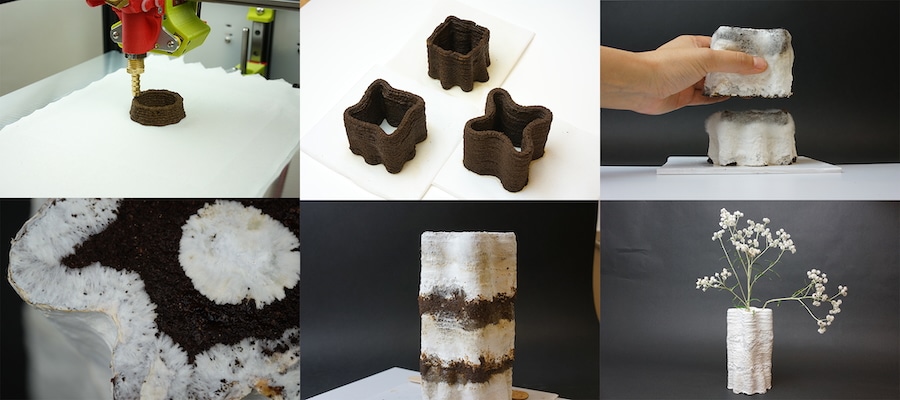This post was originally published on Eco Watch
In a new study, researchers have made a promising discovery: a compostable material that can serve as an alternative to plastic. The material is made from a combination of used coffee grounds and spores from Reishi mushrooms that are made into a paste, then 3D printed.
The idea started when Danli Luo, corresponding author of the study and doctoral student of human-centered design and engineering at University of Washington, noticed the amount of coffee grounds that accumulated from making espresso at home.
Luo, along with co-author Junchao Yang and senior author Nadya Peek, explored how coffee grounds could serve as an ideal growing base for the strong mycelial network that precedes mushroom growth. The team set out to explore a way to use up the spent coffee grounds and make them into a strong, lightweight material that would be a more sustainable alternative to plastic.
First, they turned the coffee grounds into a Mycofluid paste by combining them with the spores of Reishi mushrooms, brown rice flower, water and xanthan gum to act as a binder. This created a promising material that would work with a 3D printer.
From there, Luo developed a bespoke printer head to print the paste into more intricate and complex designs that could mimic the versatility of plastic without a need for molds. The researchers made multiple objects using the design, including shipping packing materials that could be a substitute for plastic foam (or Styrofoam), a vase, a small statue and a miniature coffin.
“We’re especially interested in creating systems for people like small businesses owners producing small-batch products — for example, small, delicate glassware that needs resilient packaging to ship,” Luo said. “So we’ve been working on new material recipes that can replace things like Styrofoam with something more sustainable and that can be easily customized for small-scale production.”
After printing, the team kept the objects moist and in a sealed plastic tub for 10 days to allow the mushroom spores to develop into a mycelial skin. Then, they removed the objects and dried them to prevent mushroom development. The team published their method in the journal 3D Printing and Additive Manufacturing.
From the upper left to bottom right: the 3D printer creates a design; three printed pieces of a vase; the partially set vase pieces are put together; the mycelium grows on the coffee paste; the vase grows together; the finished vase holds flowers and water. Luo et al./3D Printing and Additive Manufacturing
According to the authors, their method costs $1,700 for hardware for the experiment, and the 3D printer could hold up one liter of paste at a time. By comparison, they noted that other similar solutions cost more than $7,000. However, they did note that the Mycofluid paste was dependent on uniform coffee grounds, which would limit scaling ability.
Moving forward, the researchers behind the coffee-and-mushroom material also hope to explore other food waste materials that could be developed into paste for 3D printing that may have better scaling opportunity.
“We’re interested in expanding this to other bio-derived materials, such as other forms of food waste,” Luo said. “We want to broadly support this kind of flexible development, not just to provide one solution to this major problem of plastic waste.”
More and more scientists are looking into ways to make use of the estimated 60 million tons of spent coffee grounds that are wasted globally each year. For instance, New Atlas reported that RMIT University researchers found a way to incorporate spent coffee grounds into concrete to make the concrete up to 30% stronger.
Other coffee waste, such as the husks, have also been valuable to a Colombian company called Woodpecker, which has used coffee husks combined with recycled plastic to build low-cost, prefabricated buildings.
The post Coffee Grounds and Mushroom Spores Can Be 3D Printed Into a Compostable Plastic Alternative, Researchers Say appeared first on EcoWatch.





0 Comments